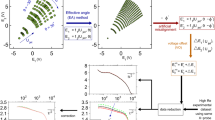Abstract
Expressions were developed to estimate the cross-flow error that occurs in the one-dimensional velocity spectra determined by applying Taylor’s frozen field hypothesis to measurements with single- and cross-wire probes. The cross-flow error and the error caused by the unsteady convection of the small-scale motions were evaluated for typical measurements. It was found that the cross-flow error could be significant in inertial range of the measured one-dimensional spectra, and was much larger than the error caused by the unsteady convection of the small-scale motions in the one-dimensional spectra of the cross-stream velocity components, \( F^{2}_{{22}} {\left( {k_{1} } \right)} \) and \( F^{1}_{{33}} {\left( {k_{1} } \right)} \). The results indicate that the one-dimensional spectra of the streamwise velocity component \( F^{1}_{{11}} {\left( {k_{1} } \right)} \) measured with a single-wire probe should be significantly more accurate than the spectra measured with a cross-wire probe. The cross-flow error in the one-dimensional spectra also becomes much less important in the dissipation range of the measured spectra.





Similar content being viewed by others
Notes
The expression for \( F^{{1m}}_{{12}} \) differs from the result given by Wyngaard and Clifford (1977). The expression reported here has been checked and seems to be correct.
References
Antonia RA, Zhou T, Romano GP (2002) Small-scale turbulence characteristics of two-dimensional bluff body wakes. J Fluid Mech 459:67–92
Batchelor GK (1953) Homogeneous turbulence. Cambridge University Press, Cambridge
Chew YT, Ha SM (1988) The directional sensitivities of crossed and triple hot-wire probes. J Phys E 21:613–620
Ewing D, George WK (2000) The effect of cross-flow on the measurement of mean square derivatives using hot-wires. Exp Fluids 29:418–428
Ewing D, George WK, Hussein HJ (1995) Spatial resolution of parallel hot-wire probes for derivative measurements. Exp Therm Fluid Sci 11:155–173
George WK, Hussein HJ, Woodward S (1989) An evaluation of the effect of a fluctuating convection velocity and the validity of Taylor’s hypothesis. In: Perry AE (ed) Proc 10th Australian fluid mechanics conference, Melbourne, 11–15 Dec, pp 11.5–11.8
Glauser MN (1987) Coherent structures in the axisymmetric turbulent jet mixing layer. Dissertation, State University of New York at Buffalo
Gotoh T, Fukayama D, Nakano T (2002) Velocity field statistics in homogeneous steady turbulence obtained using a high-resolution direct numerical simulation. Phys Fluids 14:1065–1081
Gualtieri P, Casciola CM, Benzi R, Amati G, Piva R (2002) Scaling laws and intermittency in homogeneous shear flow. Phys Fluids 14:583–596
Jorgensen FE (1971) Directional sensitivity of wire and fiber-film probes. DISA Info 11:31–37
Kolmogorov AN (1962) A refinement of previous hypothesis concerning the local structure of turbulence in a viscous incompressible fluid at high Reynolds number. J Fluid Mech 13:82–85
Ligrani PM, Bradshaw P (1987) Spatial resolution and measurement of turbulence in the viscous sublayer. Exp Fluids 5:407–417
Lomas CG (1986) Fundamentals of hot wire anemometry. Cambridge University Press, Cambridge
Lumley JL (1965) Interpretation of time spectra in high-intensity shear flows. Phys Fluids 8:1056–1062
Mi J, Antonia RA (1994) Correction to Taylor’s hypothesis in a turbulent circular jet. Phys Fluids A 6:1548–1552
Monin AS, Yaglom AM (1975) Statistical fluid mechanics, vol 2. MIT Press, Cambridge, MA
Mydlarski L, Warhaft Z (1996) On the onset of high Reynolds number grid generated wind tunnel turbulence. J Fluid Mech 320:331–368
Obukhov AM (1962) Some specific features of atmospheric turbulence. J Fluid Mech 13:77–81
Pao YH (1965) Structure of turbulent velocity and scalar fields at large wavenumbers. Phys Fluids 8:1063–1075
Praskovsky A, Oncley S (1994) Measurements of the Kolmogorow constant and intermittency exponent at very high Reynolds numbers. Phys Fluids 6:2886–2888
Saddoughi SG, Veeravilli SV (1994) Local isotropy in turbulent boundary layers at high Reynolds numbers. J Fluid Mech 268:333–372
Sreenivasan KR (1995) On the universality of the Kolmogorov constant. Phys Fluids 7:2778–2784
Wyngaard JC (1968) Measurement of small-scale turbulence structure with hot wires. J Sci Instrum 1:1105–1108
Wyngaard JC (1969) Spatial resolution of the vorticity meter and other hot-wire arrays. J Sci Instrum 2:983–987
Wyngaard JC, Clifford SF (1977) Taylor’s hypothesis and high-frequency turbulence spectra. J Atmos Sci 34:922–929
Acknowledgements
The author would like to acknowledge the contribution W.K. George made in reviewing this work and the support of the Natural Sciences and Engineering Research Council of Canada.
Author information
Authors and Affiliations
Corresponding author
Rights and permissions
About this article
Cite this article
Ewing, D. The effect of cross flow on one-dimensional spectra measured using hot wires. Exp Fluids 36, 675–684 (2004). https://doi.org/10.1007/s00348-003-0738-2
Received:
Accepted:
Published:
Issue Date:
DOI: https://doi.org/10.1007/s00348-003-0738-2




